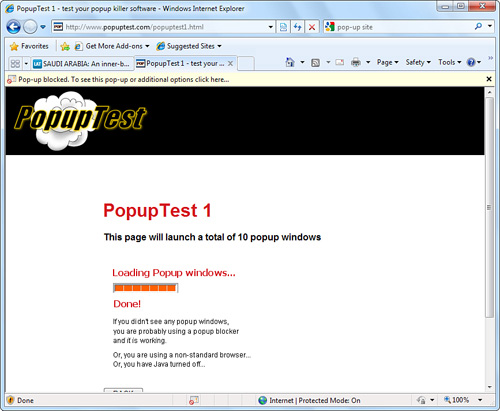3. Blocking Pop-Ups and Pop-Unders
Pop-up
windows are an intrusive means for advertisers on the Web to ensure
that you see their plug. We’ve all seen pop-up windows that appear
unexpectedly, sometimes blaring music or flashing to catch our
attention. Usually they pop up when you’ve clicked a link to go to
another page. A less intrusive, though a little more insidious, window
is called the pop-under window. You don’t discover it until you close
the window you’re looking at. This way, it’s harder to tell which site
actually spawned the pop-under, so you don’t know who to blame.
Tip
You
can stop the pop-ups dead in their tracks with this quick solution:
turn off Active Scripting (JavaScript). This works because pop-up
windows require Active Scripting to launch. Even though other browser
functions need Active Scripting, you can surf quite effectively on most
sites without it. To turn off Active Scripting, click the Tools button,
click Internet Options, select the Security tab, change your Internet
security level to High, and click OK. Five quick steps, no pop-ups, and
you haven’t spent a dime on a blocker or upgraded to the latest version
of IE. Of course, using the latest IE is a better idea because of the
improved security features and add-in management. |
Many
power users have figured out ways to prevent pop-ups, such as by
installing the Google toolbar or one of the many add-ins, or installing
some other browser, such as Opera, that blocks pop-ups. AOL’s browser
does this, as does Mozilla’s Firefox. Oddly enough, 70% or more of web
surfing is done with IE, even though prior versions didn’t contain the
modern nicety of pop-up blocking. The good news is that IE8 has a
pop-up blocker built in.
IE’s
pop-up blocker is turned on by default. When a pop-up window tries to
launch, you’ll receive notification in the IE yellow information bar
(just below the Address box). It will inform you that that a pop-up has
been blocked and list steps you can take to show the pop-up, if you
want. Click on the information bar to see the options (see Figure 6).

Sometimes it’s useful to see blocked pop-ups. Just follow these steps:
1. | Click the information bar.
|
2. | From the menu, choose Show Blocked Pop-ups.
|
Note
The
Information Bar for Pop-Ups is enabled by default in IE8, but you can
decide to turn it on or off manually. Click Tools, Internet Options.
Select the Privacy tab from the Internet Options dialog box, and click
the Settings button. Under Notifications and Blocking Level, check the
box next to Show Information Bar When a Pop-Up Is Blocked. |
Some
sites won’t work properly with pop-ups disabled, such as shopping
sites. If you want to always allow pop-ups from one or more specific
sites, you can authorize this by adding those sites to an exception
list:
1. | Click the Tools button, choose Pop-Up Blocker, and then choose Pop-Up Blocker Settings.
|
2. | In the Pop-Up Blocker Settings window, type the URL of the website, and then click Add.
|
3. | Repeat step 2 for as many sites as you want to add. When you’re finished, click Close.
|
A Few Notes About Pop-Up Exceptions
Sometimes
the pop-up blocker won’t be able to preclude a pop-up from appearing,
for several possible reasons. First, you might have software on your
computer that is launching pop-ups. To stop these pop-ups, you have to
identify the software and remove it or change its settings. Try
installing an adware and spyware sleuthing program such as Spybot
Search & Destroy, Ad-Aware, or Microsoft’s own Windows Defender
(another free real-time monitoring program for blocking pop-ups and
spyware).
Second, some pop-ups are written cleverly enough that they can circumnavigate the IE pop-up blocker.
Third,
Internet Explorer will not block pop-ups from websites that are in your
Local Intranet or Trusted Sites zones. If you want to specifically
remove such a site from your trusted zone, you can do that from the IE
Settings dialog boxes:
1. | In IE, click the Tools button, click Internet Options, and then click Security.
|
2. | Click the zone from which you want to remove a website, and then click Sites.
|
3. | Skip this step unless you chose the Local Intranet zone in the last step. Click Advanced and then go to Step 4.
|
4. | In the Websites box, click the website you want to remove, and then click Remove. |